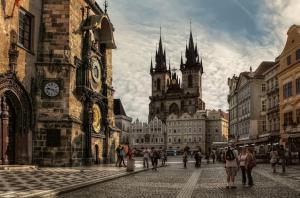 THE OLD TOWN SQUARE
THE OLD TOWN SQUARE
The Old Town Square has been a centre of the most important events in the country.
It is filled with special atmosphere, as if the exciting and often also sad events which left visible tracks in the gable roofs, lucarnes and towers, as if the stone arcades of hundred years old houses were dreaming and telling their stories aloud.
The Old Town Square was not always the noble and quiet place as it is now.
It really was a wildly beating heart of very busy and important city lying on the Europe's crossroads.
The Powder Tower was connected with the square by a noisy Celetná street, the first section of the Royal road leading across the Charle's Bridge and the Small Quarter and as far as the castle.
It served as a way for the crowning procession and for the couriers to bring all the messages, it also served as a mercantile road to Týn.
The square was roaring with markets accompanied by shouting of the vendors and zealous haggling of their customers.
In front of the Town Hall, you could find the pillory, a raised stand where the sinners were exposed to the public: gossipy hussies, sticky-fingered neighbours, aggressive youngsters and troublemakers.
It must have been shame really tremendous..
The Old Town Square also held famous knight tournaments on the occasions of kings wedding or coronation. And there was wine and food galore.
The king and his regents then announced staggering taxes and the costs were a bit more compensated.
The carnival masks were rollicking through the square and people were dancing everywhere.
When the city was besieged, the town hall's bell started to chime.
Armed townsmen gathered around the town hall and set off into the fight.
It was the Old Town's Square where the people welcomed the victorious armies, as in the times of the Battle of Vítkov where Jan Žižka was introduced to the town hall counsel.
When the town councillors and rich townsmen of the Old Town entered the Zikmund's camp, the square witnessed adversaries leading to treachery.
Jan Želivský, a propagator of rigorous revolution and an advocate of the Prague's poor people, was beheaded in the Town Hall.
As the events of Czech history were evolving, the excitement, joy, anxiety and fights, it all took place in here.
The 16th century was nearing its end, Prague was flooded with foreigners, and the kingdom perishing due to the consistent fights over the throne.
The war was bending and the eve of the Battle of Bílá Hora was coming.
The "Winter King" Fridrich of Pfalz was running away taking the Royal Road around a quiet town hall.
He left behind an abandoned, defenceless town and gave the whole country away to the despotism of Ferdinand's armies.
In almost a year, in the nice month of June, the resistant Czech noblemen were executed and their heads were displayed on the bridge tower as a terrible symbol of warning.
The Prague's alarm bells were ringing many times.
The fires coloured the sky and the square was rumbling with heavy steps of foreign troops.
The dark times were over and the 18th century arrived, the square remained unchanged.
The 19th century spoiled the ancient magic of the place by tearing down valuable buildings.
The 20th century came and brought along the 1st World War.
In the second year of the war people erected the monument of Jan Hus.
Crowds of hungry people were coming to the square and in front of the town hall they called for peace.
After October, 14th, 1918, the square was celebrating that the nation finally regained autonomy.
It was almost clear that the old square would live quietly as a dignified old man, it was as if no change was about to come.
However, a new age of darkness came about.
Its flag with swastika was knocked over by the Soviet army in the memorable May of 1945.
The fights for the May revolution had a bad impact on the square.
The town hall burnt down, the tower lost its casque, the precious horologium was shot to pieces and the ancient houses with shady arcades saved only empty, blackened walls.
Tanks were rattling through the empty space, shots were booming and flames were buzzing from the burning houses.
The Old Town's Square is never missed, for its meaning and location so close to our Tour Centre, on our Segway, Bike or Walking tours.
The experienced guides will provide you with a lot of historical context and tales necessary for understanding the history and meaning of this square.